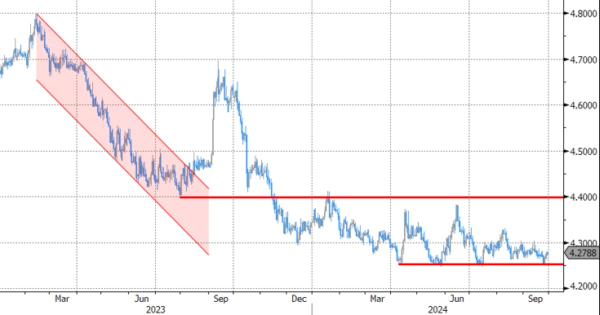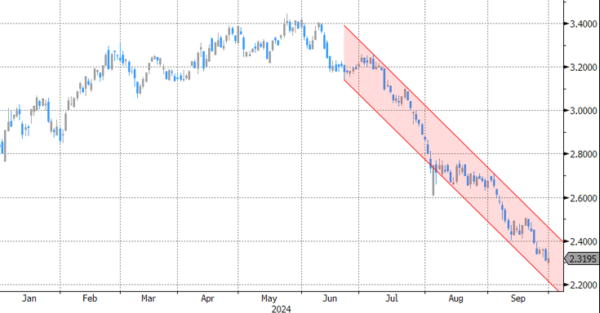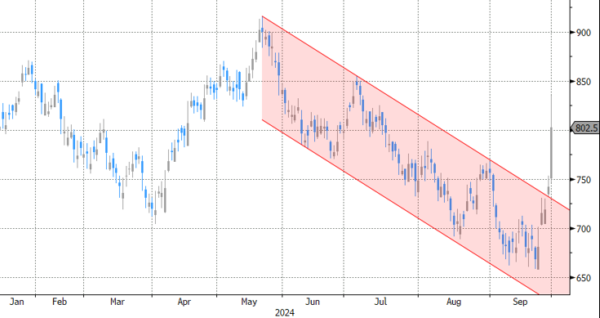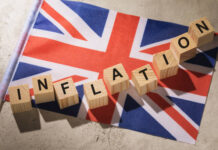Markets
With national German (and Italian) inflation data, an appearance of ECB present Christine Lagarde before the EU Parliament and Fed Chair Powell speaking before the National Association of Business Economics conference (Nashville), investors today already receive quite some interesting input to challenge their positioning regarding the outcome of the next ECB (Oct 17, unchanged or frontloading to 25 bps cut) and Fed meetings (Nov 7, 25 bps or 50 bps). German headline HICP eased further to -0.1% M/M and 1.8% Y/Y (from -0.2% M/M and 2.0% last month), but contrary to Spanish and French data on Friday didn’t bring a big downside surprise. German national data (headline 0.0% and 1.6%) released by the statistical office showed ongoing disinflation in goods (-0.3% Y/Y) with energy prices declining 7.6%% Y/Y. However, the slowdown in core inflation (2.7% from 2.8%) and services inflation (3.8% from 3.9%) proceeds only at a very gradual pace. With markets this morning discounting a 75% chance of an October ECB rate cut, some investors turned a bit more cautious. 2-y German yields intraday added 5 bps ahead the speeches of ECB’s Lagarde and Fed’s Powell. The US 2-y even added about 6 bps. At the hearing before the European Parliament, Lagarde acknowledged that Europe’s recovery is facing headwinds and saw disinflation accelerating. It might rise again due to base effects in Q4. Still, the ECB will take into account the increased confidence of taming inflation in October. With core inflation still sticky, this is no outright commitment to cut. Even so, it is no formal dismissal either. The issue might lead to an interesting (public) debate between hawks and doves that might already openly start in the coming days. EMU yields reversed most of the intraday uptick (German 2-y yield +1.0 bp, 30-y -1.0 bp). Understandably, the intraday setback in the US is much more modest. The US 2-y yield adds 5.0 bps. The 30-y +0.5 bps. Will Powell be as ‘clement’ as his European counterpart this evening? On other markets, the ongoing, stimulus-driven China equity rally doesn’t provide further spill-overs to European and/or US equity markets anymore. The Eurostoxx 50 cedes 1.0 %. US indices area easing modestly after the Dow (-0.5%) closed at a record level last Friday. Lagarde keeping the door open to at least to assess the merits of an October cut and as such a widening of the US-EMU interest rate differentials again has remarkably little impact on the euro (or the dollar). After again filling offers north 1.12 (and near the YTD top) EUR/USD currently eases only modestly to 1.1175. DXY still struggles to avoid further losses (little changed at 100.4).
News & Views
The Swiss KOF Economic barometer continued to rise in September, albeit only very slightly. It increased from 105 in August (upwardly revised from 101.6) to 105.5, the second best level since October 2021, suggesting that the Swiss economy is slowly working its way out of the trough. Details showed that almost all indicator bundles for the economic sectors point to a more favourable outlook than before with producing industries (manufacturing & construction) standing out. General business situation, export opportunities and intermediate input purchases are increasingly pointing to improvement. On the demand side, indicators for consumer demand were unchanged (slightly above average) while indicator for future foreign demand are weakening. The Swiss franc loses some ground today, but that’s not related to the data. Rising core bond yields even outweigh risk-off market sentiment, putting CHF in the defensive. EUR/CHF rises from 0.9390 to 0.9440.
September Polish inflation figures printed exactly in line with consensus, sticking with the 0.1% M/M pace from August to rise from 4.3% Y/Y to 4.9% Y/Y and further away from the National Bank of Poland’s 2.5% inflation target (with a +-1 ppt tolerance band). It’s the sixth consecutive Y/Y-increase lifting inflation to its highest level YTD. Details showed fuel prices dropping by 3.4% M/M while prices for food and non-alcoholic drinks and for electricity, gas and others both rise by 0.2% M/M. Core inflation will only be published on October 16, but the current breakdown suggests a new acceleration likely bringing core CPI back above 4% (from 3.7% in September) in Y/Y terms. Inflation developments defend the current NBP approach of sticking to the 5.75% policy rate for now and holding back from a protracted cutting cycle like local peers (eg CNB and MNB). The NBP meets on Wednesday, but the November meeting (including updated growth and inflation forecasts) will be more interesting. EUR/PLN holds near multi-year strongest levels for PLN at 4.28.
Graphs
EUR/PLN: rising inflation suggest zloty won’t lose interest rate support anytime soon.
EUR/CHF: improving growth outlook might make it less evident for SNB to reduce policy rate. CHF is holding strong.
EMU 2-y swap: Lagarde acknowledging faster disinflation and poor growth keeps EMU short-term yields under pressure.
Iron ore: propelled higher on China stimulus.


















